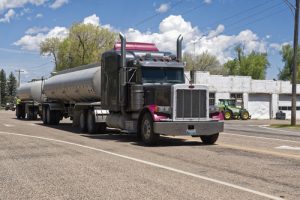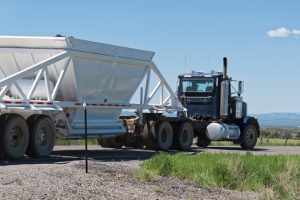DOT Hazardous Materials Safety Permit
 In addition to the USDOT Number, you are required to obtain a Hazmat Safety Permit. If you are an intrastate, interstate, or foreign motor carrier transporting certain types and amounts of hazardous materials, you need a safety permit. The mission of the safety permit is to improve truck and bus safety on the highways. It includes reducing the number of transportation incidents that involve hazardous materials that could potentially harm the public and the environment. Getting the HMSP is easy when DOT Operating Authority does your filings. Your paperwork will seem easier, as our process agents will do everything for you.
In addition to the USDOT Number, you are required to obtain a Hazmat Safety Permit. If you are an intrastate, interstate, or foreign motor carrier transporting certain types and amounts of hazardous materials, you need a safety permit. The mission of the safety permit is to improve truck and bus safety on the highways. It includes reducing the number of transportation incidents that involve hazardous materials that could potentially harm the public and the environment. Getting the HMSP is easy when DOT Operating Authority does your filings. Your paperwork will seem easier, as our process agents will do everything for you.
What is Hazardous Material?
A hazardous material is a substance or material that the Secretary of Transportation has determined can pose an unreasonable risk to health, safety, and property when transported in commerce, and has designated as hazardous. According to, Sec. 5103 of Federal hazardous materials transportation law (49 U.S.C. 5103).
What is a Hazmat Safety Permit and Who Needs it?
Safety permit means a document issued by FMCSA that contains a permit number and confers authority to transport in commerce the hazardous materials listed below.
You are not allowed to transport in interstate or intrastate commerce any of the following hazardous materials unless you hold a safety permit:
- A highway route-controlled quantity of Class 7 (radioactive) material;
- More than 25 kg (55 pounds) net weight of explosive materials or articles or an amount of Division 1.5 (explosive) material requiring placarding
- More than one liter (1.08 quarts) per package of a “material poisonous by inhalation,” that meets the criteria for “hazard zone A”;
- A “material poisonous by inhalation,” in a “bulk packaging,” that meets the criteria for “hazard zone B,”
- A “material poisonous by inhalation,” as defined in §171.8 of this title, that meets the criteria for “hazard zone C,” or “hazard zone D,” in a packaging having a capacity equal to or greater than 13,248 L (3,500) gallons;
- A shipment of methane (compressed or refrigerated liquid), natural gas (compressed or refrigerated liquid), or any other compressed or refrigerated liquefied gas with a methane content of at least 85 percent, in bulk packaging having a capacity equal to or greater than 13,248 L (3,500 gallons).
Violation Fees for Hazmat
The maximum civil penalty for a knowing violation of the hazardous materials transportation law, or a regulation, order, special permit, or approval issued under that law, range from $55,000 to $75,000. Increased maximum civil penalty ranges between $110,000 and $175,000 if the violation results in death, serious illness or severe injury to any person or substantial destruction of property.
How to Get a Hazardous Materials Safety Permit?
There are two options for filing the necessary forms to obtain a Hazardous Material Safety Permit:
- Calling DOT Operating Authority, and let our process agents do all the paperwork, or
- Submitting our online forms: MCS-150 or MCS-150B.
Motor carriers will be required to apply for an HMSP the next time they are scheduled to file the MCS-150. All motor carriers, including interstate, intrastate and foreign carriers must comply with this regulation.
For more information, feel free to call and speak to one of our representatives at DOT Operating Authority.
Federal Hazardous Materials Certification

Offerors and transporters of certain quantities and types of hazardous materials, including hazardous wastes, are required to file an annual registration statement with the U.S. DOT (Department of Transportation) along with paying a fee. DOT Operating Authority will help you with your paperwork concerning the Hazmat Certification. By calling us at 1-888-669-4383, our process agents will take care of your paperwork from the start until the end of the filings.
Who Must Register for Certification?
You must register if you are a person who offers transportation or transports in commerce a shipment containing any of the following categories of hazardous materials:
| A highway route-controlled quantity of Class 7 (radioactive) material, including enriched uranium, radioactive ores, isotopes and some medical equipment or parts. It may be shipped by highway, rail, air, or water. |
| More than one liter (1.06 quarts) per package of a “material extremely toxic by inhalation” (that is, a “material poisonous by inhalation” that meets the criteria for “hazard zone A” (for gases or for liquids). |
| More than 25 kilograms (55 pounds) of Division 1.1, 1.2, or 1.3 (explosive) material in a motor vehicle, rail car, or freight container. |
| A shipment in other than a bulk packaging of 2,268 kilograms (5,000 pounds) gross weight or more of one class of hazardous materials (including hazardous wastes) for which placarding of a vehicle, rail car, or freight container is required for that class. |
| A hazardous material (including hazardous wastes) in a bulk packaging having a capacity greater than 13,248 liters (3,500 gallons) for liquids or gases or more than 13.24 cubic meters (468 cubic feet) for solids. Please note that people who offer or transport hazardous materials that do not require placarding in a bulk packaging with a capacity greater than 3,500 gallons or 468 cubic feet, must register. |
| A quantity of hazardous material that requires placarding. The offering and transporting of hazardous materials by farmers in direct support of their farming operations are excepted from this category of activities requiring registration. |
Hazardous Materials Regulations
The HMR applies to people who offer transportation or transport by highway, rail, water, or air. Water transportation does not include hazardous materials loaded or carried on board a vessel without benefit of containers or labels and received and handled by the vessel carrier without mark or count. This type of shipment, for which the vessel is the container, such as LNG or oil tanker vessels, is under the authority of the U.S. Coast Guard.
By saying “people”, we understand each separate legal entity, such as a corporation, partnership, association, or LLC or LP. This means that a separately incorporated secondary company (or LLC or LP) must register if it engages in the specified activities, even when a parent company is also required to register.
You must also register if you engage in any of the activities:
- A merchant vessel carrier transporting, transiting, or transshipping hazardous materials within 12 miles of the U.S. coast; or
- A federal, state or local government contracting.
Penalties for Inflation
The maximum civil penalty for a knowing violation is now $78,376, except that the maximum civil penalty is $182,877 for a violation that results in death, serious illness, or severe injury to any person or substantial destruction of property. In addition, agencies are required to adjust their civil monetary penalties annually to account for changes in inflation.
DOT Operating Authority Will Help You!
At DOT Operating Authority, you will get easy and efficient help to file your documentation. We will help you register for a Federal Hazardous Materials Certification. Not only that, we also provide our customers with services like obtaining USDOT, CA, KYU Numbers, getting Biennial Updates and IFTA Filings etc.
